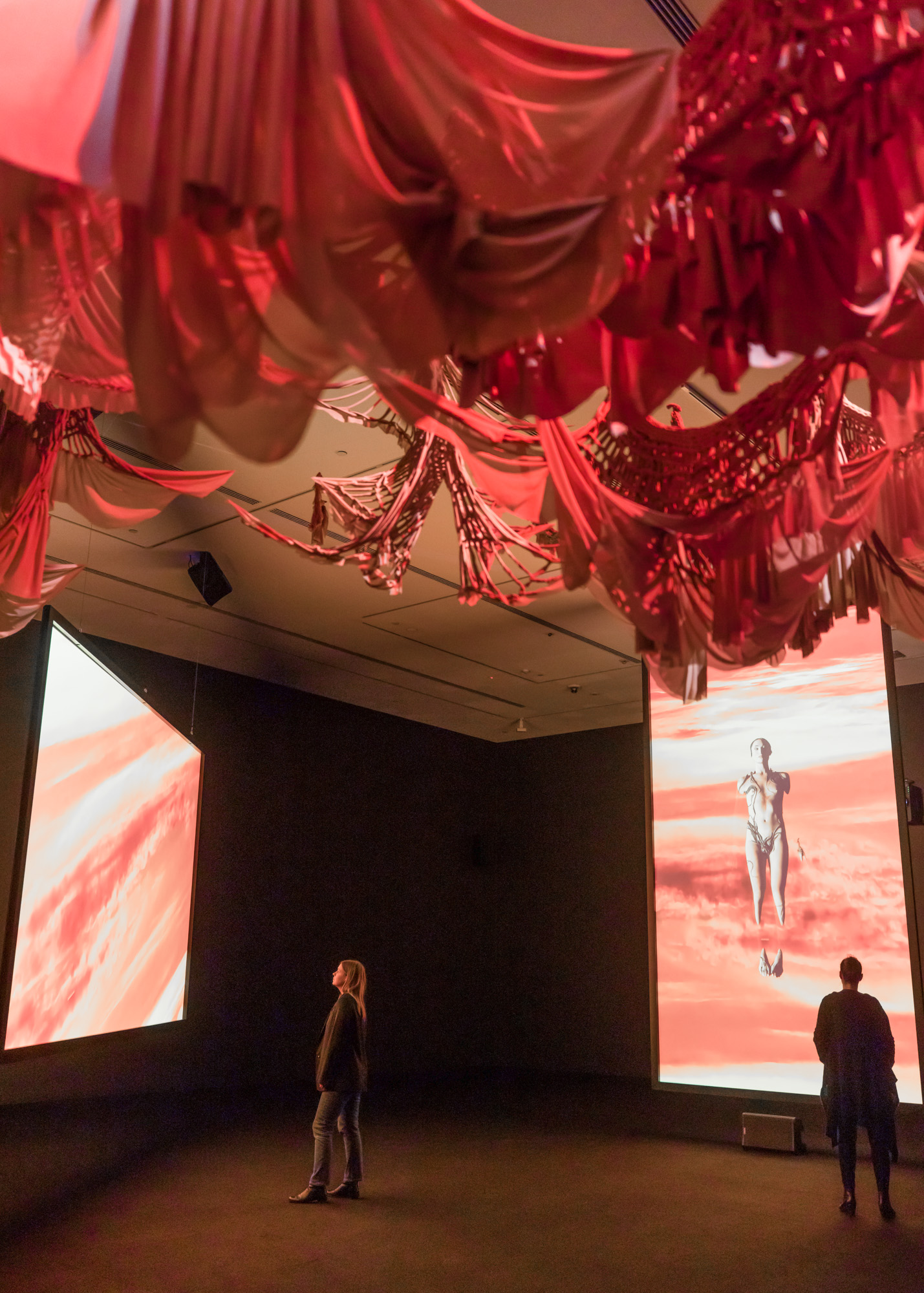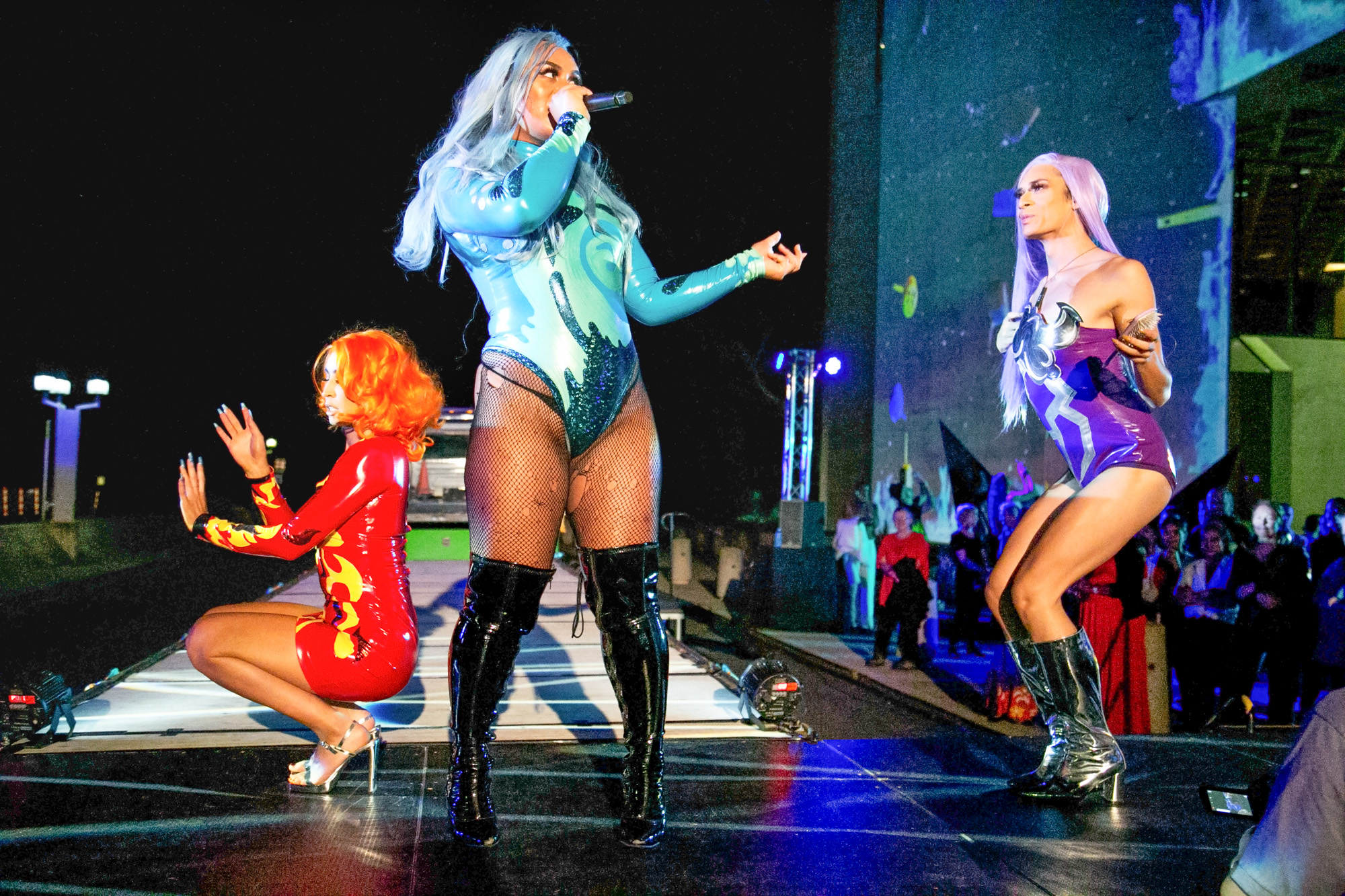Club Ate: Mythologies of Movement
By Johanna Bear

Portrait of CLUB ATE (Justin Talplacido Shoulder and Bhenji Ra). Photo by Joseph Pascual. All images courtesy the artists.
Audiences are cocooned by a reef-like canopy of woven textiles. Beyond this intimate threshold are two large screens—one horizontal, one vertical—projecting a multichannel film in a darkened room. In one scene the ancestral Buwaya (crocodile) swims across a horizon razed by smoke and fire, rippling between screens toward artist Bhenji Ra, who floats on the water’s surface with closed eyes. The haunting soundtrack amplifies as the Buwaya carries Ra skyward out of frame, like an ascending deity, drawing viewers into an enthralling and formidable world.
This installation is the latest from Bhenji Ra and Justin Talplacido Shoulder under their collective moniker, Club Ate. Titled ANG IDOL KO / YOU ARE MY IDOL (2022), it was commissioned for group exhibition “Ultra Unreal” (2022) at the Museum of Contemporary Art in Sydney. The artists occasionally appear together in the work—dancing across a dusky shoreline or sharing a candlelit Kamayan feast with collaborators who recount superstitions and stories around a Buwaya sculpted from rice. These scenes weave historical accounts of the Babaylan—queer and trans shamans who mediate between physical and spiritual realms—with precolonial animist affinities to the ancestral Buwaya and Kinnari (bird) in Filipinx mythology. ANG IDOL KO casts these figures as kindred spirits in their vision of “queer, trans, and animist idols for today.” This work refines Club Ate’s shimmering ecology of future folklore, revisiting ideas that have informed their practice from the outset.
The collective formed in 2014 after Shoulder and Ra met at a nightclub and connected through shared interests in performance, dance, and their matrilineal Filipinx heritage. Club Ate was initially the name of a one-off fundraiser at Sydney venue The Red Rattler to support communities in the Philippines devastated in late 2013 by Typhoon Yolanda. The night included performances, homemade food and halo-halo desserts, and a “mini Vogue ball.” As suggested by the word ate, Tagalog for “big sister,” the event was intergenerational and family-oriented, with a focus on connecting queer, Asia-Pacific, and particularly Filipinx communities. “There weren’t a lot of those types of gatherings, especially of people of color,” says Ra. “It was a first for us to explore our Filipino lineage as a framework for event making.”

Installation view of CLUB ATE’s ANG IDOL KO / YOU ARE MY IDOL, 2021-22, two-channel digital video: 29 min 28 sec, at "Ultra Unreal," Museum of Contemporary Art Australia, Sydney, 2022. Photo by Anna Kucera.

CLUB ATE, Ex Nilalang: From Creature ~ From Creation, 2017, still from single-channel digital video, 14 min 16 sec.
Informed by their collective ethos, Club Ate grew into an ongoing platform for collaboration and storytelling between performers, artists, sound designers, and multidisciplinary creatives. “There’s a particular magic that occurs when there’s the shared energy of multiple people and voices,” Shoulder says, describing his role as “creating a framework for play” or “an interface for people to connect.” The collective’s activation of public locales, clubs, community centers with art, performances, and Vogue balls—sometimes with home-cooked food—challenges well-worn art world orthodoxies. In offering space for people to congregate, including the historically excluded, Club Ate redraws peripheries. “Often those spaces are where we create our shared language as well,” Shoulder adds. “The DIY energy of the Philippines—the ability to create a fiesta or pageant on the corner of an alleyway and for that to be a portal into something—feels quite incredible,” Ra explains, “It’s not about belonging to a space, it’s a spirit.”
Since its inception, Club Ate’s visual language has combined Shoulder’s and Ra’s singular performance practices. Ra’s education included studies at the prestigious Martha Graham School in New York and her immersion in the city’s voguing and ballroom scenes. With Shoulder’s experience in performance, sculpture, theater, and nightlife event production, the artists animate a new movement-language.

Photo of CLUB ATE’s "In Muva We Trust," a live community event performed by Bhenji, Kilia, and Jamaica, at the National Gallery of Australia, Canberra, 2020. Photo by Aaron Bradbrook.
The performance-film In Muva We Trust (2020), first shown as a monumental projection on the facade of the National Gallery of Australia, demonstrates the significance of site in their works. The film’s imagery teems with figures moving through lush waterfalls, mossy enclaves, and celestial vistas to depict a vibrantly layered Skyworld. Often symbolized by water and the heavens, the Skyworld appears across Club Ate’s films, and in this work represents a hopeful space of communion amid uncertainty and ecological disaster. Shoulder says this space “was originally a reference to an ancient Tagalog plane and stories about the seven layers of the world,” but came to reference “a space of possibility” that “offers an inversion of sea and sky, where everything is malleable, there is multiplicity, and the body can become and interact with the non-human.” This world is transmitted into physical space through the film and Club Muva performance events—inclusive celebrations of dance and collective gathering. In this way, the work rewrites power in public spaces. Combining stories, memories, lineages, and bodies, In Muva We Trust centers queer communities of color in what Ra calls a “metaphysical space of imagination, whether a diasporic imagination outside of the motherland or a spirit.”
The work also transcends fixed understandings of place, time, and existence to reflect the concept of “future folklore.” Ra explained, “Future folklore is both ancient and very futuristic. It has this potentiality to tell stories and open up ways to enter something that isn’t held to a physical plane or single place, but a shared mother-vision of many things that are in our minds, memories, and dreams.” This manifests in works that entwine mythology and pop culture, histories and personal narratives, human and beyond-human bodies, as well as past, present, and future imaginings. Club Ate’s practice of world-building evokes Cuban American academic José Esteban Muñoz’s notion that “Queerness is essentially about the rejection of a here and now and an insistence on potentiality for another world.” Although their practice can’t be reduced to explorations of queerness alone, Club Ate highlights an expansive diasporic queerness that invites alternative approaches to Western, heteronormative understandings of existence and experience. Their universe evades definition and opens portals of possibility.
These ideas surfaced in the earlier four-episode work Ex Nilalang (2015–17), with the first three commissioned for the eighth Asia Pacific Triennial of Contemporary Art (2015–16) at Brisbane’s Queensland Art Gallery | Gallery of Modern Art. Titled with the Tagalog word nilalang, meaning both “to create” and “creature,” this epic performance-film depicts a world of spirits and more-than-human beings to explore queer diaspora identities and Filipinx creation mythologies. In the first episode, Balud (2015), elaborate makeup, props, and costuming transform performer Jai Jai into a Manananggal, an Aswang (evil spirit) whose torso detaches from her lower body and sprouts wings. Here, however, she elegantly sings Balud, a Waray song of loss and resistance. Playing upon ideas of the monstrous, Club Ate transforms a once-terrifying figure into one of awe and empathy, critiquing colonial structures that demonize non-binary and trans bodies. Ex Nilalang continues with Dyesebel (2015), merging allusions to siren folklore, the fictional mermaid Dyesebel from comic books and fantasy dramas, and the Super Sireyna beauty pageants for bakla (transgender women). In the third episode, Lolo ex Machina (2015), Shoulder becomes a jeepney-spirit through costuming and movement to communicate with his lolo (grandfather), a former jeepney (decorated public minibus) driver.
The final film, From Creature ~ From Creation (2017), departs from earlier episodes with its use of computer-generated imagery. Aquatic and galactic scenes recall the Skyworld, opening with a water vortex swirling through the galaxy. Within, Ra dances among fish and submerged relics before splitting into avatar clones that move to a pulsing beat. She reappears in a necklace, bejewelled with the word “BAKLA,” crying bulbous tears as subtitles read “[Cries in Ancient Tagalog].” The water-borne journey continues as a severed arm spawns a cybernetic dancer, played by Shoulder. He emits lightning and Pikachu-faced tabòs (washing buckets) from mechanical limbs before disintegrating into the scenery. Here, beings are not tethered to the corporeal. All things transform with the fluidity of water and mourning gives way to rebirth. Club Ate’s aqueous, technological world reveres marginalized bodies and the stories, knowledge, and cultures they carry.
Club Ate offers a cosmos of possibility by drawing from reality yet remaining unbounded by it. To experience their work is to encounter something alive, synergetic, and rich in imaginative potential. Describing their practice as an “act of creating, prophesying, or visioning the future,” Ra says it “opens up portals or ways to think about shifts in the world; shifts in thinking, dominance, or any kind of power struggle.” Yet despite continually experimenting with form and aesthetic language, their practice stays tethered to relationships—with their ancestral motherland and their communities, whether familial or chosen.








